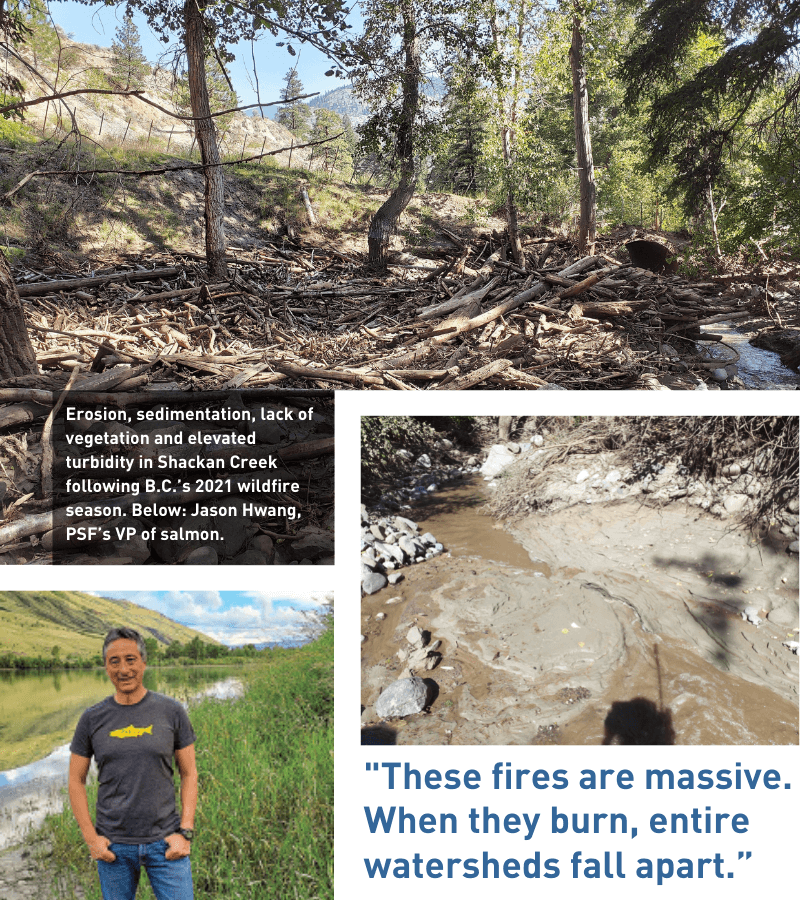FOREST FIRE PLAYBOOK
AFTER ONE OF THE PROVINCE’S MOST DEVASTATING WILDFIRE SEASONS YET, PSF PUTS A PLAN IN PLACE TO ENSURE SALMON ECOSYSTEMS CAN ALWAYS REBOUND
Salmon Steward: Winter 2021
B.C.’s 2021 wildfire season was the third-worst on record in terms of total area impacted. Compounded with this summer’s heatwaves and droughts, Pacific salmon certainly felt the burn.
Wildfires can cause major changes to forests and soils, which leads to shifts in watersheds that have serious consequences for salmon and their habitat. Experts and climatologists forecast that Canada will endure increasingly intense and frequent wildfires in the coming years. As we all learn how to live with this new reality, planning for salmon is essential.
Wildfires burn the vegetation holding soil together and destabilize the surrounding landscape. As a result, loose mud, debris and sediment flow into critical habitat.
Once excess sediment reaches a stream, it can plug salmon gills and make it difficult for fish to breathe, prevent salmon from accessing food, degrade critical riffle and pool habitat, and bury salmon eggs.
“These fires are massive. When they burn, entire watersheds fall apart. The efforts put into salmon recovery become swamped by the effects of these large wildfires,” notes Jason Hwang, Pacific Salmon Foundation’s VP of salmon. “These fires can affect salmon for years or even decades.”
Unfortunately, at the moment, there is no plan that considers the effects of major fires on aquatic ecosystems. PSF is working to change that by developing a Forest Fire Playbook that will explore landscape strategy options for salmon during the wildfire season. “If these fires are going to continue happening, how can we mitigate effects, accelerate recovery and try to prevent some of these consequences to support salmon populations?” says Hwang.
PSF’s Playbook will engage experts in fields such as forest management, urban development and fish habitat restoration to identify common erosion-control and sedimentation-prevention measures. Applying these techniques to salmon ecosystems could stabilize soils and the areas that feed water into sensitive salmon habitat, preventing sediment and debris from smothering them. This year’s wildfire season demonstrates the scale of instability that massive fires can inflict on aquatic ecosystems. Shackan Creek, which feeds the Nicola River and supports at-risk populations of Steelhead trout and Coho salmon, was devastated by the summer fires. Heavy rainfalls in mid-August likely triggered wildfire-induced sediments to wash into Shackan Creek, according to Paul Mozin, biologist with the Nicola Watershed Stewardship and Fisheries Authority.
Recent surveys of Shackan Creek have revealed significant destabilization characterized by bank erosion, high sediment loads, a lack of riparian vegetation and elevated water turbidity.
And yet, “most of the damage is still to come,” Mozin explains. “The system is still extremely unstable and it will be for a number of years. It could be over a decade.”
As B.C.’s wildfires intensify in the wake of climate change, planning around how fires impact watersheds and salmon will be critical, especially for watersheds most prone to fires. PSF’s emerging Forest Fire Playbook will act as a catalyst to equip streamkeepers, scientists and officials with tools to mitigate the impact on salmon and advance recovery.
Planning and development for the Playbook is currently underway, and PSF expects to have a first draft available by March of 2022.
WHAT KIND OF “PLAYS” COULD THIS PLAYBOOK INCLUDE?
- HYDROSEEDING – a common erosion-control technique employed on construction sites,
using mulch and grass seed to stabilize bare soils. - DESIGNING AREAS to catch sediment before it can enter streams, a method that is used mostly in urban development.
- ACCELERATING RECOVERY of riparian vegetation via techniques like replanting or willow stakes, which could speed up the recovery of ecosystems and reduce erosion in the short term.
- POST-FIRE LOGGING practices that minimize impacts on watershed hydrology and recovery.
- REFORESTATION that, more than just regrowing timber, strives to restore hydrological and geomorphological processes, with the goal of restoring the ecological function of watersheds; this
should be reflected in tree species selection and silviculture practices.
THE BIG PICTURE
OUR DEVELOPING FOREST FIRE PLAYBOOK for salmon recovery is part of PSF’s larger Climate Adaptation Program, which is working on several projects that will help salmon in the face of climate change. To learn about PSF’s critical climate work, made possible by the British Columbia Salmon Restoration and Innovation Fund, visit psf.ca/work/climate.



